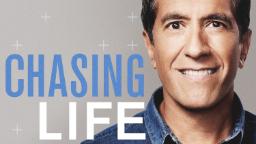
Dr. Sanjay Gupta
00:00:00
Hey there, it’s Sanjay. Summer is almost over, and for many of us, that means returning to work or school. Now it’s normal to feel nervous in some social settings from time to time. But for second grade teacher Jo Berlanga, it goes way beyond that.
Definitely, my heart is racing. My whole body is hot. My thoughts are not straight. I cannot speak clearly. Yeah, it’s all of just through my nerves. I mean, they’re just going full throttle and I don’t know, you know, how to contain it or calm it down. I just try to breathe through it.
Dr. Sanjay Gupta
00:00:38
But the funny thing is this — when she’s in front of her second grade students …
I’m normal. I show up every day. I come in. The kids are familiar with a routine. I’m used to a routine. And so everything is pretty normal and calm and consistent.
Dr. Sanjay Gupta
00:00:56
Jo’s fear only kicks in when she’s faced with big groups of adults.
I think that whenever I’m with a group of peers, colleagues or in a team meeting, I may seem like I’m calm, but inside, just internally, I cannot get my thoughts straight.
Dr. Sanjay Gupta
00:01:14
For many of you, Jo’s experience may sound familiar. Social anxiety affects 15 million Americans, making it one of the most common mental health disorders in the country. That’s according to the NIH. But what exactly is it? And what can we do to feel better? Today, we’re going to decode social anxiety and look at some of the steps you can take to help yourself and others feel less fearful, less awkward. I’m Dr. Sanjay Gupta, CNN’s chief medical correspondent. And it’s time to start chasing life.
Ellen Hendriksen
00:01:51
Social anxiety, most generally, is a disproportionate fear of being judged or rejected.
Dr. Sanjay Gupta
00:01:58
That’s Ellen Hendrikson, a clinical psychologist at Boston University’s Center for Anxiety and Related Disorders. She says some degree of social anxiety is actually pretty normal. But it can also be a serious clinical disorder if it meet certain criteria.
Ellen Hendriksen
00:02:14
There are two thresholds. One is distress. And that essentially means that we’re suffering. So, for example, if we lose sleep or we get stomachaches because we’re so anxious, then that’s distress. It means we’re suffering. The other threshold is impairment, and that means we’re not living the life we want to live. So my classic example is a student who deliberately foregoes part of their grade because they’re not willing to raise their hand and get those class participation points.
Dr. Sanjay Gupta
00:02:43
Let’s spend a minute just talking about treatment then. Someone has come to see you and you’ve diagnosed individual social anxiety. What are the the various options in terms of treatments?
Ellen Hendriksen
00:02:54
So I do cognitive behavioral therapy, which posits that if we can challenge the way we think and change the way we act, then that will change the way we feel. So what we will usually do is to create this gigantic list of all the things that the person wants to do but is avoiding. And then we rank it from easiest to hardest and work our way through. And so I will do a lot of these things alongside my clients. And so, you know, in the name of, you know, social anxiety treatment, I’ve done some interesting things. I’ve spilled my coffee in a crowded Starbucks. I have asked for lemongrass in a hardware store, like I’ve gone jogging with clients. We will do a lot of things that for whatever reason, they, you know, are worried about doing. And so we will work our way through. So that’s the behavioral aspect. And we’ll also challenge thoughts and beliefs like people are going to reject me if I don’t present like really perfectly. Do we really have to be articulate and funny and not awkward in order to be accepted? No, there’s probably some wiggle room there. So trying to challenge the beliefs that really maintain social anxiety as well as trying to face our fears, is really this magical one two punch that can really work wonders for folks who have lived with social anxiety for a long time.
Dr. Sanjay Gupta
00:04:19
That’s sort of the cognitive behavioral therapy, right? And then you also talk about mindfulness based stress reduction as well. Right. Is that another option?
Ellen Hendriksen
00:04:30
Generally, there are two big buckets of treatment options. So one bucket is change. And so what I described with cognitive behavioral therapy squarely falls into that bucket. We’re trying to change thoughts, we’re trying to change behaviors, but there’s this whole other bucket called acceptance. And there that is where mindfulness falls in, because all these thoughts that we’re having that people are going to think I’m a loser or people are going to think I’m awkward or I’m not any good at this. Those are just thoughts, right? Thoughts aren’t truth. But we can train ourselves to observe those thoughts as they come flying at us. We can learn to just recognize, oh, this is what my brain does. These are the things my inner critic throws at me. But we don’t have to react to those things. And we can still, you know, be friendly and open and start conversations, even though those thoughts are there.
Dr. Sanjay Gupta
00:05:30
And what about exposure therapy or immersion in this? Is that a good idea to immerse?
Ellen Hendriksen
00:05:37
So I’m of the school that slow and steady wins the race. So I am more of the person who encourages clients to dip their toe into the pool and kind of inch their way in as opposed to doing a cannonball into the deep end. That can work. It’s certainly, you know, more painful. But I think regardless, exposure therapy should be exactly that. You should expose yourself to your fears, face your fears, try to drop those safety behaviors, but at the same time, go at your own pace. Be kind to yourself.
Dr. Sanjay Gupta
00:06:06
Again, this is such a personal topic for me because of, you know, I’m raising three teenage girls. But if you see someone in your life, a friend, coworker, family member, and you think that they may have some of these traits that you’re describing, they are socially anxious. Is it best to approach them, to ask them about it, to intervene in some way or not?
Ellen Hendriksen
00:06:29
Our urge is often to accommodate them to say, oh, well, okay, well, you don’t have to do that. Or well okay, maybe we’ll think in our heads, but I won’t invite you to my next party because I know you would hate that. However, there is a fine line between accommodating and enabling, and so I would say to talk to them and say, you know, how can I support you? How can I encourage you? If you can sense that they’re feeling anxious before an event or you’re about to go out, you can say, well, remember, you know, last time like you were nervous, but then after 10 minutes, you really settled in. Or I remember, you know, last time you wanted to bail also, but you were really glad you went att the end of the day. You can be their champion and remind them that they can do hard things as opposed to, you know, accommodating to the point of enabling. And I think there’s a little bit of both that are appropriate. Encourage them, be their champion and allow them, you know, an escape hatch. Absolutely. You know, want to hold their feet to the fire.
Dr. Sanjay Gupta
00:07:28
If you’re someone who lives with social anxiety, it is important to remind yourself there are a lot of people just like you out there and that there are things you can do about it on your own right now. Here are some tips from Professor Hendrikson to help us manage our social anxiety in the moment and feel more comfortable at any sort of get together. Tip number one, if you’re in the grip of anxiety during a social interaction, turn your attention outward.
Ellen Hendriksen
00:07:55
Pay attention to the person you’re talking to. You know, look at their face, listen to their words, and essentially turn that spotlight outward. It makes it easier to connect. And it, in addition, makes you come across as more attentive, more genuine, more authentic, and you have more bandwidth to pay attention to the moment.
Dr. Sanjay Gupta
00:08:18
Tip two: Next time you go to an event, make a game plan ahead of time.
Ellen Hendriksen
00:08:23
You can say you’re going to talk to a certain number of people. You’re going to appoint yourself as the the unofficial photographer. You can ask people to sign the guestbook, etc.. Give yourself a role and that will give you more certainty.
Dr. Sanjay Gupta
00:08:37
Tip number three: Don’t put off facing your fears.
Ellen Hendriksen
00:08:41
We often feel like we want to retreat from the world and work on ourselves and then emerge newly confident and ready to take on the world. But instead switch those. Put action first. Do the things that you’re afraid of, kindly, slowly. And your confidence will catch up.
Dr. Sanjay Gupta
00:09:01
Tip four: Resist the urge to be perfect.
Ellen Hendriksen
00:09:05
Allow yourself some wiggle room to make mistakes, to have an awkward pause here or there, to trip over your words. Social relationships don’t hinge on the last conversation, so it’s okay to lower the bar and to focus on connection rather than your performance.
Dr. Sanjay Gupta
00:09:26
And finally, I think it’s only fitting that our last tip comes from second grade teacher Jo Berlanga, who we heard from earlier.
I do a lot of, a lot of just deep breathing. And I try to get my attention, my mind away from what is coming or what’s going to happen. But when you’re there, you’re there.
Dr. Sanjay Gupta
00:09:47
It’s a great tip and it might actually seem pretty obvious, but simply taking a few deep breaths really activates what is known as our parasympathetic nervous system, which controls the body’s ability to relax. Try it yourself. It works almost immediately. Now, these tips may not completely erase social anxiety, but they can help calm our nerves, especially when they’re in overdrive. I’ve already started putting some of them into action, and I can tell you that my interactions with people are more joyous and they’re more genuine as well. It’s a question of trying to be as present as possible without letting our own minds get in the way. And sometimes that can really help alleviate social anxiety. We’ll be back next week with a special preview of my colleague and friend Anderson Cooper’s brand new podcast. You won’t want to miss it. Chasing Life is a production of CNN Audio. Megan Marcus is our executive producer. Our podcast is produced by Emily Liu, Andrea Kane, Xavier Lopez, Isoke Samuel, Grace Walker and Allison Park. Tommy Bazarian is our engineer and a special thanks to Ben Tinker, Amanda Sealy, Carolyn Sung and Nadia Kounang of CNN Health, as well as Rafeena Ahmad, Lindsey Abrams and Courtney Coupe from CNN Audio.


























































